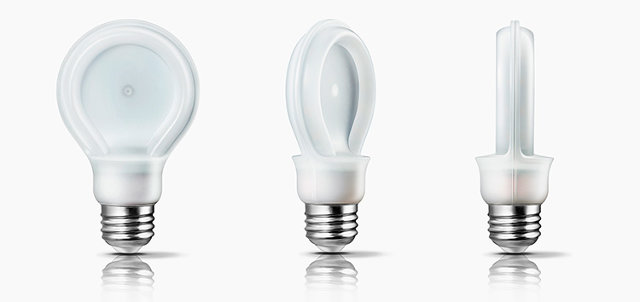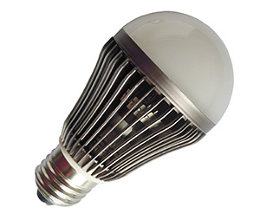Why Philips Flattened The Light Bulb
Introducing the SlimStyle, a pancake-shaped light bulb that represents the LED industry's latest attempt to court skeptical consumers.
Yesterday, a federal ban on production of 40- and 60-watt incandescent bulbs went into effect, forcing consumers to switch to more efficient (if less aesthetically pleasing) bulbs, like LEDs and CFLs. Philips wants to make that switch as painless as possible. So today, the lighting giant is releasing an inexpensive LED light bulb that also happens to be as flat as a pancake. Could this be the bulb that finally endears consumers to LEDs?
Some background on the LED lighting market: LED bulbs cut down on energy use, compared with incandescents, and can last up to 20 years, where an incandescent might last less than one. But LEDs have struggled to gain traction with shoppers. One reason is ambiance: unlike incandescent bulbs, which emit a warm, flattering glow, LEDs tended to shine an unforgiving blue-tinted light. A second problem is price: incandescents can cost less than a buck each, while LED bulbs can cost around $20 a pop. One of the reasons for the extra cost is a heavy (and expensive) metal heat sink that Philips (and competitors Cree and GE) include on the bulb's base.

With SlimStyle, Philips has slashed the price roughly in half (Cree has previously issued a $10 bulb as well, but with 40 watts versus the SlimStyle's 60). The secret: the pancake shape, which helps eliminate the need for a heat sink.
In 2011, Philips engineers tinkered with the remote phosphor technology that can convert blue light into a more appealing indoor light, but to do that, they needed to use more LED diodes. The traditional bulb shape made it such that they had to cluster the diodes together closely. One problem: LEDs get hot quickly, and overheating can cut down on the bulb's longevity. Engineers, then, had to add a heavy metal heat sink to the bulb's base to draw away heat. That addition made the bulbs more expensive.

But by flattening the bulb, Philips has eliminated the need for a heat sink. The flat shape allowed Philips engineers to arrange LED diodes in a horseshoe. So now, instead of the diodes emitting heat in a tight little cluster, they radiate heat outward, across the surface of the bulb, in an arc.
As for maintaining the contour of a traditional incandescent bulb (albeit a 2-D version): Todd Manegold, director of LED at Philips, says that maintaining some elements of familiarity is key to courting wary consumers. Philips learned the hard way. In 2011, the company released the AmbientLED 12.5-watt A19 LED lightbulb, which produced an odd yellow afterglow when it was switched off, baffling many consumers. With SlimStyle, the company hopes it has created something both innovative and recognizable.
More experiments with LEDs will surely to follow. "LEDs are now going into a state where companies can challenge what you expect from a light bulb," Manegold says. As an example, he cited the Philips Hue lighting system, which lets you stage an LED light show via an app. Looking ahead, Manegold says, the progression of LED technology could empower designers to worry less about mimicking incandescents. "My goal is that when you put it behind a lamp shade you can't tell it's an LED," he says. "But that doesn't mean it has to be the Edison bulb that was designed over 100 years ago."
The SlimStyle will be available through Home Depot starting today, at $9.97 each.
Enviado desde mi iPad
Comentarios